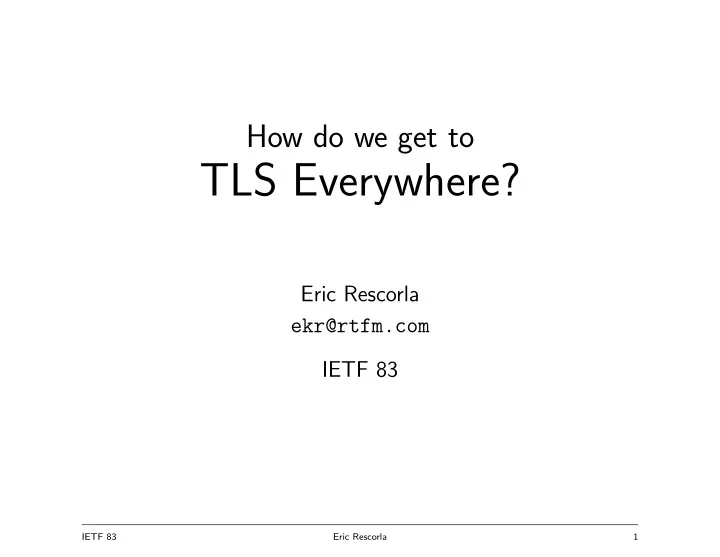

How do we get to TLS Everywhere? Eric Rescorla ekr@rtfm.com IETF 83 IETF 83 Eric Rescorla 1
Web security depends on communications security • Most of the Web threat model just assumes traffic confidentiality and integrity – Which means HTTPS • On paper things look pretty good – Lots of standards ∗ Over 27 TLS WG RFCs – Every major browser and server supports SSL/TLS ∗ Though browsers tend to run older versions IETF 83 Eric Rescorla 2
Actual picture is much worse • The vast majority of Web traffic is not encrypted [CAP10] • About 1% of sites even offer HTTPS [KKG + 10] • This number should be 100% IETF 83 Eric Rescorla 3
What’s going on? • Certificates are a huge mess – Too hard to get for the right people – Too easy to get for the wrong people • Hard to deploy once you have a certificate – Mixed content – People still type http:// • Performance concerns – Real but a distinctly low order bit IETF 83 Eric Rescorla 4
Getting a certificate “I can’t f’ing figure out how to get a cert from go daddy - kid you not ... god help people that don’t know what a CSR is ... I am like 45 minutes in ” Cullen Jennings, PhD — Cisco Fellow Former IETF Area Director IETF 83 Eric Rescorla 5
Can we dispense with certificates? • Lots of designs for alternative site authentication schemes • For example, store the keys in DNS (secured with DNSSEC), aka DANE • Could we replace X.509 with these? IETF 83 Eric Rescorla 6
Alternative certificate systems: a collective action problem • Current situation: all browsers support X.509/PKIX – No browsers support anything else • Any server which wants to have TLS must have both credentials – Until practically all clients support the new system – This means clients get no benefit from the new system ∗ So little pressure to add client-side support ∗ Which means little value in server deployment • When can a server stop supporting PKIX? Ever? • Note: this doesn’t apply to systems intended to restrict PKIX certs IETF 83 Eric Rescorla 7
Worked Example: Server Name Indication • Original design of TLS supported one server per IP – Even though HTTP allows virtual servers via Host header – This makes TLS virtual hosting very expensive with IPv4 • TLS Server Name Indication (SNI) fixed this problem in 2003 [BWNH + 03] – Now supported almost everywhere ∗ – ... but not on IE on Windows XP (XP is 30% of market !) • So still not totally safe to run an SNI-based server ∗ http://en.wikipedia.org/wiki/Server_Name_Indication IETF 83 Eric Rescorla 8
Converting people to HTTPS • So you’ve turned on HTTPS, now what? – Users still type http:// • You could HTTP redirect them to HTTPS site – But now you have an active attack/downgrade problem – We need this to be as secure/sticky as possible • Possibilities – Redirects + HSTS? – SPDY upgrade (but what about HTTP?) – DNS records? – HTTPS Everywhere? – Something else? IETF 83 Eric Rescorla 9
Active Mixed Content • All JavaScript (JS) code on a page runs in the same security context – No matter where it was retrieved from – And it has access to basically all the page data • What happens when you load a script over HTTP – From an HTTPS page – “Active mixed content” • An attacker can modify the insecure JS – And completely owns your page • Not much better than running everything over HTTP – (But still better) IETF 83 Eric Rescorla 10
Modern Web pages are full of external scripts IETF 83 Eric Rescorla 11
Modern Web pages are full of external scripts IETF 83 Eric Rescorla 12
Modern Browsers Don’t Like Active Mixed Content IETF 83 Eric Rescorla 13
Mixed-Content: Another collective action problem • Say I turn on HTTPS for my site – But I have all these HTTP dependencies – Now everything breaks! • And it gets worse as browser manufacturers clamp down – (But this is an important security feature) • How do we square incremental deployment with mixed content protection? – We want everyone to gradually migrate to TLS – But they won’t do it if everything breaks when they turn it on IETF 83 Eric Rescorla 14
Summary • Web security depends critically on communications security ... which means TLS • Needs to be easier to use TLS everywhere – Make getting server-side credentials easier ... and harder for attackers – Making it safe to turn on HTTPS on your own site ... even in the face of mixed content – Automatically converting HTTP users to HTTPS users ... as securely as possible IETF 83 Eric Rescorla 15
References [BWNH + 03] S. Blake-Wilson, M. Nystrom, D. Hopwood, J. Mikkelsen, and T. Wright. Transport Layer Security (TLS) Extensions. RFC 3546, Internet Engineering Task Force, June 2003. [CAP10] Tom Callahan, Mark Allman, and Vern Paxson. A Longitudinal View of HTTP Traffic. In Proc. Passive and Active Measurement: PAM 2010 , April 2010. [KKG + 10] Michael E. Kounavis, Xiaozhu Kang, Ken Grewal, Mathew Eszenyi, Shay Gueron, and David Durham. Encrypting the internet. In Shivkumar Kalyanaraman, Venkata N. Padmanabhan, K. K. Ramakrishnan, Rajeev Shorey, and Geoffrey M. Voelker, editors, SIGCOMM , pages 135–146. ACM, 2010. IETF 83 Eric Rescorla 16
Recommend
More recommend